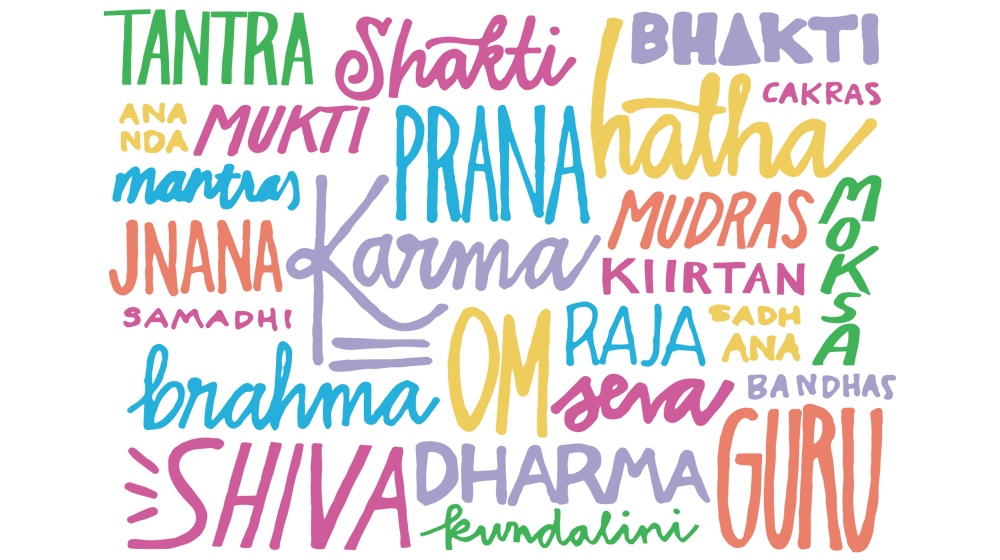Is yoga a religion? Defining yoga’s most spiritual terms

Is yoga a religion? It’s infused with Sanskrit words, Indian cultural trappings, even Hindu practices. Practitioners meet in sacred spaces, assume particular poses, sometimes have photos of their teachers on altars.
Though yoga is often taught as a purely physical exercise in some gyms and studios, there are many people who embrace yoga as a deeply spiritual way of life.
So the answer may depend on how you define your terms. The original etymology of the word religion is “religare” — to bind together. From that perspective, yoga (whose own meaning is “to unite”) seems close to the original meaning of religion.
Still, this is a fraught question, because for some, religion has come to stand for a set of (often dogmatic) beliefs, whereas yoga in its best sense aspires to be an experiential search for meaning.
In my memoir The Curve of the World, I describe my experiences with a yoga-based spiritual organization in India called Ananda Marga. Our focus was on cultivating a relationship with the divine, and the question of whether yoga was a religion sometimes did come up. And yet, we chose to distinguish yoga from religion because of the distinction between practical experience and dogmatic belief.
There are many paths in yoga, but they share common, historically rooted, spiritually oriented terms. These terms suggest that yoga is a many-faceted practice with a rich philosophical, historical and cultural legacy. However you choose to embrace it, understanding the language of yoga may offer more perspective on your own practice.
Bhakti is devotion, the rich, heart-stirring longing for connection with the divine.
Cakra (I prefer the original Sanskrit pronunciation, pronounced with a “ch” as in children) are energy centers within the body associated with certain mental propensities. In the West, they’ve been linked up with all sorts of associations. You might consider going back to some original texts to understand their context.
Dharma refers to the underlying nature and purpose of a thing. Just as the dharma of fire is to burn, the dharma of a human being, most yogis would say, is spiritual growth.
Guru means “dispeller of darkness.” Teachers can be useful, and sometimes indispensable, though it’s important to exercise discretion in choosing a guru. The ultimate guru is within, symbolizing one’s connection to the divine.
Hatha, Sanskrit for “force,” describes the physical side of yoga, or asanas.
Jnana yoga (pronounced gyana) deals with knowledge and study, including the questions “who am I?” and “what am I?”
Karma yoga works towards non-attachment to the results. Seva, or selfless service, is a wonderful way to get your ego out of the way. (Karma also refers to samskara, the reaction to an action waiting to be expressed, as in “good karma.”)
Kiirtan, a heart-centered practice of chanting, singing and dancing, is becoming quite popular.
Kundalini is the coiled serpentine energy located at the base of your spine. When kundalini is aroused, it passes upwards through the various cakras until it reaches the pineal gland, along the route generating blissful sensations.
Mantra, which means “that which liberates the mind,” is a word or phrase, usually in Sanskrit, repeated during meditation to bring focus. Mantras are traditionally considered sacred and powerful phrases.
Mudras and Bandhas are physical practices that have specific effects on the body and mind.
Mukti refers to liberation while keeping one foot in the world, while moksa is complete merger in God.
Namaste is a Sanskrit greeting (in the eastern part of India, they say “namaskar”) literally meaning “I greet the divine spark within you, with all the charms of my mind and cordiality of my heart.” It is often accompanied or substituted by a small bow with the palms of the hands together, held over the heart cakra.
Om — more accurately spelled aum — is the primordial sound; each of the three letters a, u and m represent the three seed sounds of creation, preservation and destruction. It’s a popular practice, although the teacher Anandamurti says there’s really nothing special about chanting this sound and that you might better try to perceive the om sound in meditation.
Prana flows through our bodies as vital energy, and through everything else, too. Pranayama controls this energy by regulating the breath with ideation.
Sadhana is another word for meditation. The goal of union in yoga is pursued through sadhana. Making this effort, the mind gets immersed in pure consciousness, and you experience ananda, or bliss. This suspension of mind is known as samadhi.
Shiva and shakti represent mind and energy on a cosmic level. Shiva is the cognitive (conscious) force; shakti the creative force, or nature. Together, they compose brahma, the supreme. (Some confusion often arises here since Shiva is also considered a deity in Hinduism, as are Brahma and Vishnu.)
Tantra is a loose set of practices and philosophies; the word literally means “that which liberates through expansion.” The essence of tantra is seeing everything as sacred, as something to be learned from.
Writer, musician and activist Andy Douglas lives in Iowa City. His memoir The Curve of the World: Into the Spiritual Heart of Yoga was released in 2013. He holds an MFA in creative writing from the University of Iowa. This article was originally published in YogaIowa’s Winter 2018 issue.


